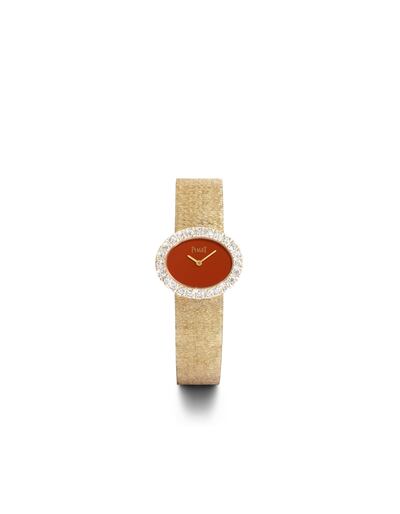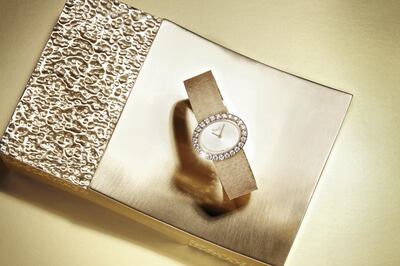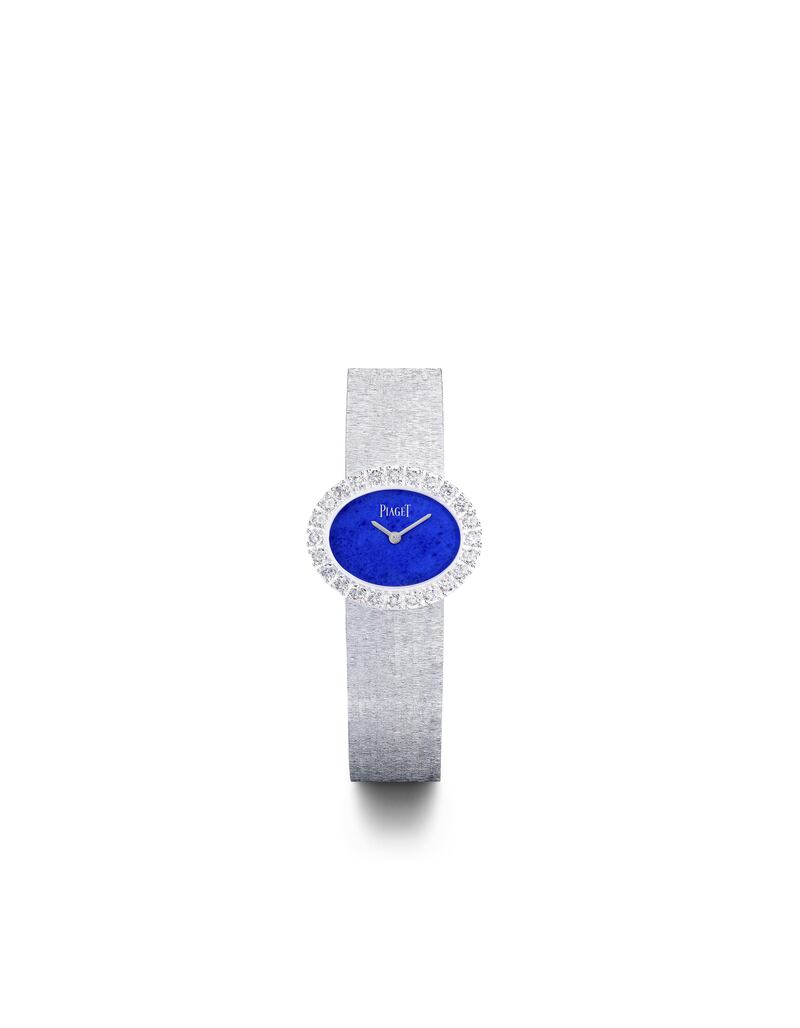As a general style rule: if it was good enough for Jacqueline Kennedy Onassis, it is good enough for us.
When it came to capturing the former first lady's inimitable style for Pablo Larraín's 2016 film, Jackie, starring Natalie Portman as the wife of president John F Kennedy, the accessories and jewellery she wore were as important as the clothes. As such, Portman appears in the film wearing a selection of creations by Piaget, including an original Traditional watch once owned by the style icon herself.
The oval watch-face is encircled by 20 brilliant-cut diamonds. A simple, unadorned dial is crafted from jade, and set with green tourmalines at 3, 6, 9 and 12 o’clock. The hands are two simple strokes of gold. But it is the timepiece’s strap that really steals the show. Handcrafted by Piaget’s skilled artisans, the yellow gold bracelet is weighty and substantial, and a striking example of the brand’s mastery when it comes to working with the precious metal. The bracelet is hand-engraved in Piaget’s so-called Palace style, which creates an almost iridescent effect, as if it were embedded with microscopic gems. Inspired by techniques from the world of haute couture, the Palace design consists of countless interwoven links that come together to form what Piaget refers to as “a golden fabric of unrivalled lightness”. Inside the watch sits a 56P quartz movement, also manufactured in-house. With its pure lines and uncluttered design, the overall effect is deceptively simple.
Part of Piaget's Traditional collection, this classic jewellery-watch is one of the brand's most iconic creations. The standard version comes with a silvered dial, paired with either a white or pink gold strap, and 24 diamonds circling the oval-shaped dial, which measures 27 millimetres by 22mm. To coincide with the international release of Jackie, at the beginning of this year, Piaget launched two new editions of the timepiece — one with a natural turquoise dial paired with a white gold bracelet, which is priced at £56,500 (Dh273,900), and another featuring a natural red cornelian dial perfectly complemented by a pink gold bracelet, which is priced at £51,000 (Dh247,200). The addition of these bold stones adds a new dimension to an already striking design.

More recently, the watch was used as a source of inspiration by the Dubai-based Lebanese accessories designer Nathalie Trad, who created two clutch bags that take their design cues from iconic Piaget watches. In an ode to the Traditional watch, Trad references the intricacy of Piaget’s goldsmithing techniques in a wave-like rectangular clutch that intersperses smooth and craterous surfaces. Trad also created a clutch inspired by Piaget’s Limelight Gala timepiece — the round pearl-toned shell bag is bordered in gold-toned brass that mirrors the distinctive asymmetric lines of the watch. “Doing a collaboration like this has always been a dream,” says Trad. “I’ve always been a fan of Piaget, so designing these pieces, based on a brand that has so much history and so much richness to it, was so organic and so easy; I could almost design a whole collection based on it.”

This isn’t the first time that the luxury brand has endorsed Dubai’s emerging fashion talent. In 2016, Piaget hand-picked local fashion designers to create stylish ensembles to correspond with the launch of its Limelight Gala Milanese watch. Regional designers Asma and Amna Khaled Saif of AKS, Asma Al Matrooshi of Epiphany and Manaal Al Hammadi were asked to design ready-to-wear looks inspired by the watch, along with couture outfits inspired by the Traditional timepiece.
Furthermore, during this year’s Art Dubai, Piaget joined forces with the Cultural Office of Her Highness Sheikha Manal bint Mohammed bin Rashid Al Maktoum, and announced the launch of a new art project targeting untapped talent in the Middle East. Artists had a chance to submit their works, inspired by the theme The Sunny Side of Life, to the Cultural Office, and the winner’s creation will be exhibited during Art Dubai in March 2018.
Artistry has always been at the heart of the Piaget promise – and this is particularly true when it comes to its watches with gold bracelets. “Here, gold yields to precious stones giving the wrist exceptional sparkle,” says the company’s website. In the way it combines fine goldsmithing techniques and precious gem stones, the Traditional watch is evocative of a golden era in Piaget’s history, and is a symbol of what has long been the brand’s defining USP – it is a watchmaker and a jeweller in equal measure. The brand more poetically refers to this duality as “the fusion of time and light”.
Piaget is a watchmaker-jeweller in the purest sense. The brand was first established in the Swiss municipality of La Côte-aux-Fée in 1874, when Georges-Édouard Piaget set up a workhouse in the family farmhouse and proceeded to create high-precision watch movements. By the 1950s, Piaget had set about designing and manufacturing the ultra-thin movements that would become one of its trademarks (its Calibre 9P hand-wound movement and Calibre 12P self-winding movement were both the thinnest in the world in their categories, when they were launched in 1957 and 1960, respectively). It was also around this time that the brand developed its now signature style – a bold combination of intricately worked gold, explosive colours, precious gems, unconventional shapes and dials made from hard stones.
Today, more than one million precious stones are set each year in Piaget’s specialised high-jewellery workshops; and the watchmaker still reigns as a master of the ultra-thin movement (over half of the movements currently developed at the manufacture are currently ultra-thin, and some are barely as wide as a strand of human hair).
For generations, Piaget’s workshops have preserved and developed crafts that have all but disappeared elsewhere. Over 40 separate professions are practised within the Piaget manufacture, from master gemmologists, jewellers and gem-setters, to designers and goldsmiths. In the workshops, high-tech devices sit alongside traditional wooden buffs; links, gadroons and miniature shafts are carved from gold, one by one, millimetre by millimetre; finishes are handcrafted to the nth degree; and specialist craftsmen carry out over 14 different decorative techniques, including circular-graining, bevelling, circular Côtes de Genève, polishing and engraving the Piaget coat-of-arms.
The end products are works of art that are as relevant today as they were in the late 1800s, or the mid-1900s, when they sat on the wrist of Jackie O, one of the most stylish women in the world.
__________________
Read more:
[ New Piaget Possessions collection is unexpectedly colourful ]
[ Mohammed Al Habtoor, Abdulla Al Kaabi and Piaget offer alternative view of Dubai ]
[ Piaget revives its iconic Limelight Gala timepiece ]
__________________







